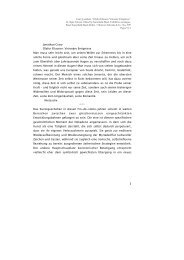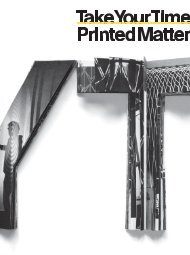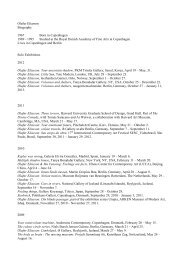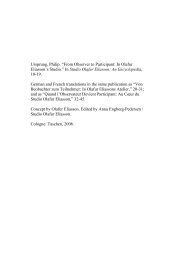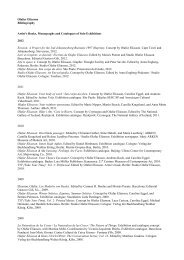Studio Olafur Eliasson
Studio Olafur Eliasson
Studio Olafur Eliasson
Create successful ePaper yourself
Turn your PDF publications into a flip-book with our unique Google optimized e-Paper software.
Writings<br />
studio simply marks the addition of another skilled worker—a<br />
discourse worker. With so much of <strong>Studio</strong> <strong>Olafur</strong> <strong>Eliasson</strong>’s energy<br />
directed towards discourse production—besides the works, this<br />
includes seminars and publications, an operational archive, and a<br />
pedagogical model for a new art school—these often unquantifiable<br />
aspects of the activity around a practice become a vital form of<br />
currency within the practice. 2 And <strong>Eliasson</strong>’s incorporation of a<br />
critic into the equation doesn’t mean omitting others: a vital aspect<br />
of Engberg-Pedersen’s role is to work closely with critics, theorists,<br />
and historians on collaborative projects. 3 These collaborative projects<br />
not only contextualize aspects of the studio’s activity but can also<br />
generate new ideas to be fed back into the studio.<br />
Since 2008, <strong>Studio</strong> <strong>Olafur</strong> <strong>Eliasson</strong>’s enormous macro-studio has<br />
been housed in a converted brewery in Berlin-Prenzlauer Berg.<br />
The studio’s top floor is split into two parts: the smaller used as a<br />
painting atelier, and the larger, more provisional part, used for<br />
spatial experiments like the one I experienced on my first visit. The<br />
floor below is dedicated to the art school <strong>Eliasson</strong> has established,<br />
including studio spaces for the students—a series of studios set within<br />
the larger studio. Below this there is another hub of activity: the<br />
Model room (2003), a wunderkammer of models serving as the backdrop<br />
for a number of my dialogues with studio employees. This is<br />
followed by an administrative and archiving area where the discourse<br />
workers sit (and where I’m assigned a temporary work station)<br />
and banks of desks for architects. Library shelves, and a series of<br />
paste-up boards full of compelling images of projects in various<br />
stages of development, including a building for a Right Bank wine<br />
estate in Bordeaux and the headquarters of an investment company<br />
in Vejle, Denmark, act as room dividers. A door at the far end leads<br />
through to <strong>Eliasson</strong>’s private study. Downstairs, through the metal<br />
workshop, the ground floor opens out onto a giant space for<br />
62<br />
<strong>Studio</strong> <strong>Olafur</strong> <strong>Eliasson</strong><br />
rehearsing installations, followed by a production area, and then<br />
<strong>Eliasson</strong>’s own personal studio space. On my first visit, <strong>Eliasson</strong> is<br />
experimenting with small stones and concave wall-mounted mirrors<br />
for a new series of small projected works. Opposite his study is the<br />
kitchen and a long dining table where lunch is served daily. Finally, nestled<br />
in the basement, is the wood workshop and general storage area. 4<br />
<strong>Eliasson</strong> also has a micro-studio in Copenhagen where he spends<br />
part of the week. The morning of the first day of my visit in summer<br />
2010, Sebastian Behmann, the studio’s principal architect, diligently<br />
outlines the micro-studio’s layout and purpose: “It has two<br />
spaces: one an office space and the other a more flexible design<br />
or production space, both being relatively small. The Copenhagen<br />
studio is a more contemplative studio space. … We also have<br />
images and models of our current projects on the walls there. This<br />
gives [<strong>Eliasson</strong>] the opportunity to reflect on them and for us to talk<br />
without the pressures of the main studio here in Berlin.” Speaking<br />
with <strong>Eliasson</strong> on the same day in the lunch queue I ask him about<br />
his third studio—a mobile-studio in Iceland. “It’s basically an old<br />
camper van with a bubble on top. I use it to take photographs of<br />
the landscape and sometimes to paint,” he says. 5 Each of these studios<br />
is important to <strong>Eliasson</strong>’s creative process: the mobile-studio<br />
being where he can be alone amidst the relative silence of Eidar in<br />
Iceland; the micro-studio affording <strong>Eliasson</strong> and key studio members<br />
the space to reflect without the pressures of a large studio; and the<br />
macro-studio facilitating the production of it all, while also hosting<br />
the parallel activities of the school and the seminars.<br />
Every architect, painter, technician, tutor, theorist, administrator,<br />
craftsman, and cook in the Berlin studio—currently between forty<br />
and forty-five in total—conduct themselves quietly and conscientiously.<br />
Other than in the noisy workshops, no music is played—<br />
the only sounds are those of work: quiet chattering in multiple<br />
63



